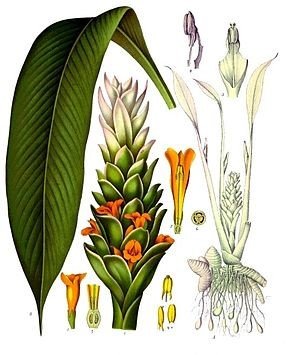Turmeric is a perennial herb native to southern Asia. Its dried and powdered rhizome is a very popular spice. Turmeric is particularly present in the socio-cultural life of the Indian subcontinent, where it is considered an exceptional plant given its numerous properties. Turmeric is the subject of numerous scientific studies around the world with the aim of better understanding its nutritional and medical properties.

Turmeric is a perennial, herbaceous plant with short stems. This plant can reach 1 meter in height. It has numerous aromatic rhizomes of orange-yellow color inside. Its large leaves are green and measure up to 50 cm long. Turmeric requires plenty of sunlight and very fertile soil. Harvesting the rhizomes can begin when the stem begins to dry. This happens about 7-8 months after planting. The rhizomes are removed from the soil and left to rest for a few hours to stabilize the humidity level. They are then sorted and cleaned with water.
Turmeric has been cultivated since ancient times in India. It is frequently mentioned in literature from the 4th century. In the 18th century, turmeric was imported to Europe by the great naval powers (Holland, United Kingdom, Portugal and France). It is used both for its dyeing and medicinal properties.
Virtues
Turmeric is a spice full of virtues, each more impressive than the last!
In Ayurvedic medicine (traditional medicine from India), as well as in traditional medicines from China and Japan, turmeric is used to stimulate digestion, in particular because it increases bile secretion. These properties are universally recognized so much so that this rhizome is marketed worldwide.
For several years, substances have been isolated from the rhizomes of turmeric, to which we have given the name curcuminoids. These are very powerful antioxidants that are useful for various inflammatory disorders, healing ulcers, wounds as well as lesions caused by scabies.
Researchers believe that curcumin's antioxidant and anti-inflammatory effects may play a role in the prevention and treatment of cancers . In vitro studies already indicate that curcumin inhibits the proliferation of cancer cells by acting at various times during their development and that it promotes the production of enzymes that help the body get rid of cancer cells.
Turmeric also has protective effects on the gastric mucosa and it can destroy or inhibit the bacteria Helicobacter pylori , which causes most gastric and duodenal ulcers . One study showed a 75% cure rate with doses of 3g of turmeric per day for 12 weeks.
Turmeric has an anti-inflammatory effect. Indeed, doses of 2g per day for 6 weeks produced effects comparable to ibuprofen on people suffering from osteoarthritis .
Did you know ?
The English name for turmeric is turmeric. What a funny name !
Well actually no, this name is completely logical 🙂 The English name is inherited from the French terre métro , itself coming from the Latin terra maerita , which designated the root because of its earthy substance and because it was known to have great virtues.
Find this virtuous ingredient in the Tonic Assaisonnette and enhance all your dishes
